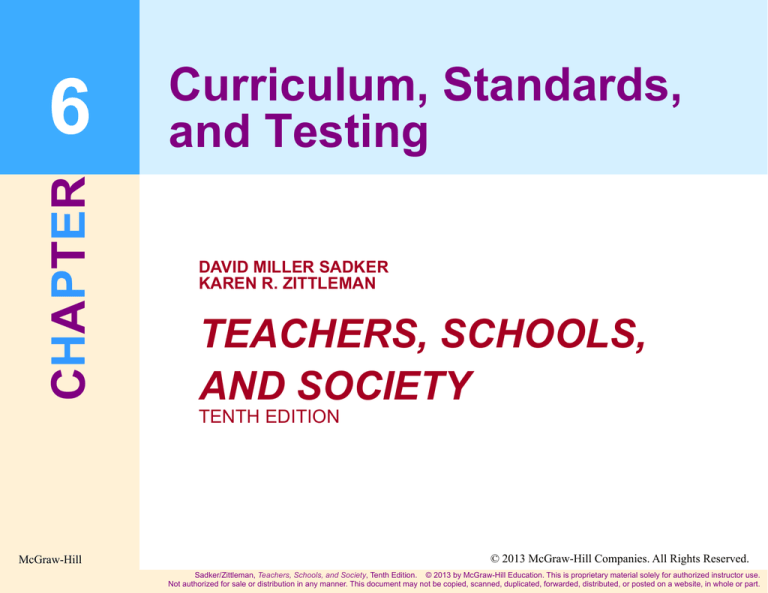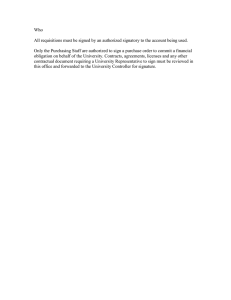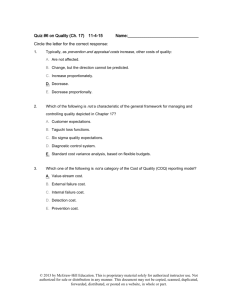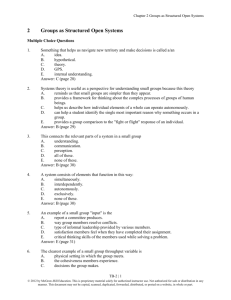
CHAPTER
6
Curriculum, Standards,
and Testing
DAVID MILLER SADKER
KAREN R. ZITTLEMAN
TEACHERS, SCHOOLS,
AND SOCIETY
TENTH EDITION
McGraw-Hill
© 2013 McGraw-Hill Companies. All Rights Reserved.
Sadker/Zittleman, Teachers, Schools, and Society, Tenth Edition. © 2013 by McGraw-Hill Education. This is proprietary material solely for authorized instructor use.
Not authorized for sale or distribution in any manner. This document may not be copied, scanned, duplicated, forwarded, distributed, or posted on a website, in whole or part.
6.1
CURRICULAR TIME LINE
TIME
EDUCATIONAL
PHILOSOPHY
FOCUS OF CURRICULUM
Seventeenth
Century
“Two Rs”
Secondary education for males
only; reading and religion
Eighteenth
Century
Life in the present
Reading, religion, morality,
writing, and arithmetic; vocational
skills; academy open to females
Nineteenth
Century
Secular education
Secondary education in Latin or
English curriculum
Early Twentieth
Century
Progressive education
Creative expression; junior high
school developed; secondary
education for all students
6-2
Sadker/Zittleman, Teachers, Schools, and Society, Tenth Edition. © 2013 by McGraw-Hill Education. This is proprietary material solely for authorized instructor use.
Not authorized for sale or distribution in any manner. This document may not be copied, scanned, duplicated, forwarded, distributed, or posted on a website, in whole or part.
6.2
CURRICULAR TIME LINE (continued)
TIME
EDUCATIONAL
PHILOSOPHY
1940s-1960s
Discipline-oriented
Congress funded programs in
science, math, languages, and
guidance
1960s-1970s
Social concern and
humanistic education
Gender-based courses;
multiethnic curricula
1980s
Back to basics
Academic subjects emphasized;
increased discipline; elimination
of electives; competency exams
1990s
Widening of the core
curriculum
Expansion of the core curriculum
to include more people of color
and women
Current
_____________
________________
FOCUS OF CURRICULUM
6-3
Sadker/Zittleman, Teachers, Schools, and Society, Tenth Edition. © 2013 by McGraw-Hill Education. This is proprietary material solely for authorized instructor use.
Not authorized for sale or distribution in any manner. This document may not be copied, scanned, duplicated, forwarded, distributed, or posted on a website, in whole or part.
6.3
HIDDEN CURRICULUM?
Student-Generated Responses: What else did you learn in school?
GRADE LEVEL
“HIDDEN” LESSONS
Elementary
Middle
High School
6-4
Sadker/Zittleman, Teachers, Schools, and Society, Tenth Edition. © 2013 by McGraw-Hill Education. This is proprietary material solely for authorized instructor use.
Not authorized for sale or distribution in any manner. This document may not be copied, scanned, duplicated, forwarded, distributed, or posted on a website, in whole or part.
6.4
THE IMPORTANCE OF EXTRACURRICULAR ACTIVITIES
AND ACADEMIC SUBJECTS
Do you consider extracurricular activities as important as the academic
subjects, or do you consider them as only a supplement to the academic
subjects?
National Totals
%
No Children in
School
%
Public School
Parents
%
As important as
academic subjects
42
40
46
A supplement to
academic subjects
56
58
52
Don’t know
2
2
2
6-5
SOURCE: Lowell C. Rose and Alec M. Gallup (2000), The 32nd Annual Phi Delta Kappa/Gallup Poll of the Public’s Attitudes Toward the Public Schools, http://www.pdkintl.org/kappan/kpol0009.htm#1a
Sadker/Zittleman, Teachers, Schools, and Society, Tenth Edition. © 2013 by McGraw-Hill Education. This is proprietary material solely for authorized instructor use.
Not authorized for sale or distribution in any manner. This document may not be copied, scanned, duplicated, forwarded, distributed, or posted on a website, in whole or part.
6.5
SHAPING THE CURRICULUM
6-6
Figure 6.1
Sadker/Zittleman, Teachers, Schools, and Society, Tenth Edition. © 2013 by McGraw-Hill Education. This is proprietary material solely for authorized instructor use.
Not authorized for sale or distribution in any manner. This document may not be copied, scanned, duplicated, forwarded, distributed, or posted on a website, in whole or part.
6.6
WHO AND WHAT SHAPE THE CURRICULUM?
Student-Generated Responses
WHO & WHAT
EXAMPLES OF HOW
1. Students
2. Parental and community groups
3. Teachers
4. Administrators
5. Federal government
6. State government
7. Local government
8. Colleges and universities
9. Standardized tests
10. Education commissions and
committees
11. Professional organizations
12. Special interest groups
6-7
Sadker/Zittleman, Teachers, Schools, and Society, Tenth Edition. © 2013 by McGraw-Hill Education. This is proprietary material solely for authorized instructor use.
Not authorized for sale or distribution in any manner. This document may not be copied, scanned, duplicated, forwarded, distributed, or posted on a website, in whole or part.
6.7
6-8
Figure 6.2
TEXTBOOK ADOPTION STATES
SOURCE: Association of American Publishers, Washington, DC, 2011.
Sadker/Zittleman, Teachers, Schools, and Society, Tenth Edition. © 2013 by McGraw-Hill Education. This is proprietary material solely for authorized instructor use.
Not authorized for sale or distribution in any manner. This document may not be copied, scanned, duplicated, forwarded, distributed, or posted on a website, in whole or part.
6.8
FORMS OF BIAS
Student-Generated Responses
EXAMPLES
BIAS
Invisibility
Stereotyping
Imbalance/selectivity
Unreality
Fragmentation/isolation
Linguistic bias
Cosmetic bias
6-9
Sadker/Zittleman, Teachers, Schools, and Society, Tenth Edition. © 2013 by McGraw-Hill Education. This is proprietary material solely for authorized instructor use.
Not authorized for sale or distribution in any manner. This document may not be copied, scanned, duplicated, forwarded, distributed, or posted on a website, in whole or part.
6.9
6-10
Figure 6.3
STATES THAT ADOPTED
THE COMMON CORE STANDARDS
SOURCE: http://www.corestandards.org/in-the-states.
Sadker/Zittleman, Teachers, Schools, and Society, Tenth Edition. © 2013 by McGraw-Hill Education. This is proprietary material solely for authorized instructor use.
Not authorized for sale or distribution in any manner. This document may not be copied, scanned, duplicated, forwarded, distributed, or posted on a website, in whole or part.
QUESTIONS ABOUT
6.10 COMMON CORE STANDARDS
• Is there consensus on a single set of core
standards for all states?
• Are all states onboard?
• Do the standards reflect an appropriate direction
for schools?
• Is a single set of common core standards
desirable?
• Are common core standards the right direction for
America’s schools?
• What will testing be like for these standards?
6-11
Sadker/Zittleman, Teachers, Schools, and Society, Tenth Edition. © 2013 by McGraw-Hill Education. This is proprietary material solely for authorized instructor use.
Not authorized for sale or distribution in any manner. This document may not be copied, scanned, duplicated, forwarded, distributed, or posted on a website, in whole or part.
SEVEN REASONS WHY STANDARDIZED TESTS
6.11 ARE NOT WORKING
1. At-risk students placed at greater risk
2. Lower graduation rates
3. Higher test scores do not mean more learning
4. Standardized testing shrinks the curriculum
5. Test errors
6. Teacher stress
7. What’s worth knowing?
6-12
Sadker/Zittleman, Teachers, Schools, and Society, Tenth Edition. © 2013 by McGraw-Hill Education. This is proprietary material solely for authorized instructor use.
Not authorized for sale or distribution in any manner. This document may not be copied, scanned, duplicated, forwarded, distributed, or posted on a website, in whole or part.
6.12 TEACHING TO THE TEST
6-13
SOURCE: Education Week, Quality Counts, 2001.
Sadker/Zittleman, Teachers, Schools, and Society, Tenth Edition. © 2013 by McGraw-Hill Education. This is proprietary material solely for authorized instructor use.
Not authorized for sale or distribution in any manner. This document may not be copied, scanned, duplicated, forwarded, distributed, or posted on a website, in whole or part.
6.13 TEACHER STRESS
6-14
Figure 6.4
SOURCE: http://ganesh.ed.asu.edu/aims/view_image.php?image_id572&grade_range_id53 . See also Tirupalavanam Ganesh,
“Held Hostage by High-Stakes Testing: Drawing as Symbolic Resistance,” Teacher Education Quarterly (2002).
Sadker/Zittleman, Teachers, Schools, and Society, Tenth Edition. © 2013 by McGraw-Hill Education. This is proprietary material solely for authorized instructor use.
Not authorized for sale or distribution in any manner. This document may not be copied, scanned, duplicated, forwarded, distributed, or posted on a website, in whole or part.
6.14 CAMPBELL’S LAW
“The more any quantitative social indicator is
used for social decision-making, the more
subject it will be to corruption pressures and
the more apt it will be to distort and corrupt the
social processes it was intended to monitor.”
—Donald T.
Campbell
6-15
Sadker/Zittleman, Teachers, Schools, and Society, Tenth Edition. © 2013 by McGraw-Hill Education. This is proprietary material solely for authorized instructor use.
Not authorized for sale or distribution in any manner. This document may not be copied, scanned, duplicated, forwarded, distributed, or posted on a website, in whole or part.
6.15 DO YOU BELIEVE IN EVOLUTION?
6-16
Figure 6.5
SOURCE: “Trend Lines: Acceptance of Evolution,” Washington Post, January 16, 2007.
Sadker/Zittleman, Teachers, Schools, and Society, Tenth Edition. © 2013 by McGraw-Hill Education. This is proprietary material solely for authorized instructor use.
Not authorized for sale or distribution in any manner. This document may not be copied, scanned, duplicated, forwarded, distributed, or posted on a website, in whole or part.
6.16 EXAMPLES OF CENSORSHIP
Mary Rodgers’ Freaky Friday: “Makes fun of parents and parental responsibility.”
Plato’s Republic: “This book is un-Christian.”
Jules Verne’s Around the World in Eighty Days: “Very unfavorable to Mormons.”
William Shakespeare’s Macbeth: “Too violent for children.”
Fyodor Dostoyevsky’s Crime and Punishment: “Serves as a poor model for young people.”
Herman Melville’s Moby Dick: “Contains homosexuality.”
Anne Frank’s Diary of a Young Girl: “Obscene and blasphemous.”
E. B. White’s Charlotte’s Web: “Morbid picture of death.”
J. R. R. Tolkien’s The Hobbit: “Subversive elements.”
Roald Dahl’s Charlie and the Chocolate Factory: “Racist.”
Mark Twain’s The Adventures of Huckleberry Finn: “Racism, insensitivity, and offensive
language.”
Webster’s Dictionary: “Contains sexually explicit definitions.”
Justin Richardson and Peter Parnell’s And Tango Makes Three, for being anti-ethnic and
anti-family, homosexuality, religious viewpoint, unsuited to the age group.
Philip Pullman’s His Dark Materials trilogy for the political viewpoint, religious viewpoint,
and violence.
6-17
Alvin Schwartz’s Scary Stories for occult/satanism, religious viewpoint, and violence.
Sadker/Zittleman, Teachers, Schools, and Society, Tenth Edition. © 2013 by McGraw-Hill Education. This is proprietary material solely for authorized instructor use.
Not authorized for sale or distribution in any manner. This document may not be copied, scanned, duplicated, forwarded, distributed, or posted on a website, in whole or part.
6.17 THE DIGITAL DIVIDE ON COMPUTER USE
6-18
Figure 6.6
SOURCE: National Center for Education Statistics, Digest of Education Statistics, 2009 (issued April 2010).
Sadker/Zittleman, Teachers, Schools, and Society, Tenth Edition. © 2013 by McGraw-Hill Education. This is proprietary material solely for authorized instructor use.
Not authorized for sale or distribution in any manner. This document may not be copied, scanned, duplicated, forwarded, distributed, or posted on a website, in whole or part.



